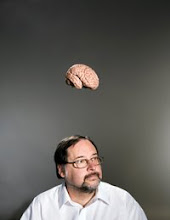 Author, professor and neuroscientist John Medina has written a book called Brain Rules in which he unpacks the mysteries of the brain with a series of rules that can apply to a whole host of topics, not the least of which is preaching.
Author, professor and neuroscientist John Medina has written a book called Brain Rules in which he unpacks the mysteries of the brain with a series of rules that can apply to a whole host of topics, not the least of which is preaching.He recently blogged about Brain Rules for Public Speaking - I bet he has something to tell you about preaching. Check it out below:
Scott Berkun recently interviewed John Medina for his blog Speaker Confessions. Scott asks the question: what makes public speakers good or bad? He's working on a book to answer that question.
SB: How can a lecturer use attention, but make sure not to abuse it? Or put another way, does repetitive use of phasic alertness, getting an audience to refocus their attention ever few minutes, have declining effects over time?
JM: I do not believe in entertainment in teaching, during the holy time information is being transferred from one person to another. I do believe in engagement, however, and there is one crucial distinction that separates the two: the content of the emotionally competent stimulus (“hook”). If the story/anecdote/case-history is directly relevant to the topic at hand (either illustrating a previously explained point or introducing a new one), the student remains engaged. Cracking a joke for the sake of a break, or telling an irrelevant anecdote at a strategic time is a form of patronizing, and students everywhere can detect it, usually with resentment, inattention or both.
Do you think the size of a classroom has any effect on students ability to pay attention? Does Posner’s model of attention change if we are alone in conversation, vs. in an audience of 99 other people listening to a lecture?
I don’t think the size of the classroom has anything to do with the functional neural architecture proposed by Posner, but there is a universe of difference in how it behaves. The behavior has to do with our confounded predilection for socializing. People behave very differently in large crowds than they do in small crowds or even one on one. Very different teaching strategies must be deployed for each.
Bligh’s book “What’s the use of Lectures?” identifies 18-25 minutes, based on his assesment of psychology studies, as the key breakpoint for human attention in classrooms. Whether it’s 10 or 25, why do you think so few schools or training events use these sized units as the structure for their days, or their lessons?
I don’t know why schools don’t pay attention to attention. Perhaps it is a lack of content knowledge. If I had my way, every teacher on the planet would take two courses: First, an acting course, the only star in the academic firmament capable of teaching people how to manipulate their bodies and voices i to project information. Second, a cognitive neuroscience course, one that teaches people how the brain learns, so teachers can understand that such projections follow specific rules of engagement.

No comments:
Post a Comment